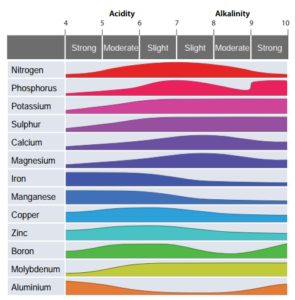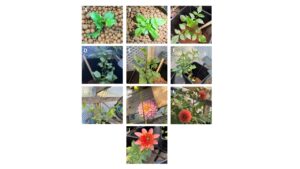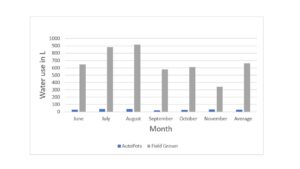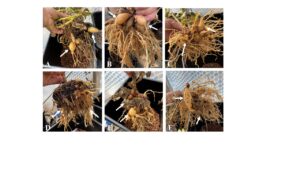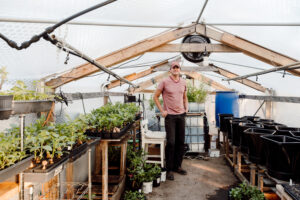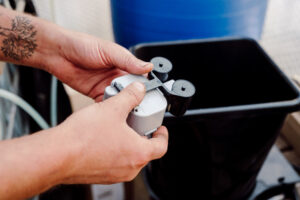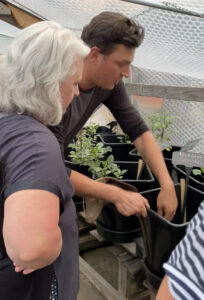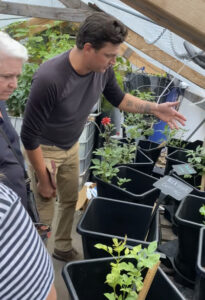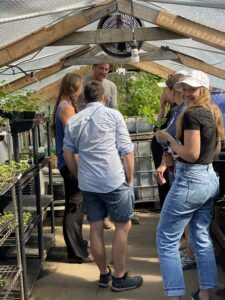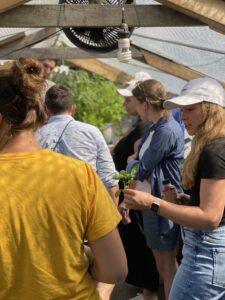Final report for FNE21-991
Project Information
We sought to prove that Dahlias could be grown and would flower in an aquaponics system via AutoPots, and that certain characteristics would be measured, as well as establishing the environmental benefits of such an approach. We grew six cultivars of Dahlias from two origination tissue types, tuber and rooted cutting, in aquaponics fed AutoPots, for six months. We measured a number of parameters including growth rate, stem counts, plant health, aquaponic system health, bloom size and quality, water savings, and tuber formation. We logged, recorded, captured, and transcribed results and then summarized them via tables, graphs, and figures. We showed definitively that Dahlias can be grown in aquaponics via AutoPots, water savings was on par with what previous research has established (95%), stem counts were lower than field grown counterparts, pesticide usage was about the same as field grown, bloom size and quality was not affected, growth rate was typical of field grown, and tuber formation was not impacted. We disseminated the results of this research through an article that we are submitting for publication, Instagram posts throughout the study, website updates, podcast interviews, on farm tours and demonstrations, collaborations with aquaponics service providers, and engagement from the flower farming community through direct communication. We ultimately reached the public, consumers, florists, floral designers, and flower farmers with this data and had a robust and lively response from them about the potential it demonstrates!
This project validated that aquaponics coupled with Autopots was a viable growing method for dahlia cut flower production. The project characterized this method and documented the benefits of using aquaponics for dahlia production. The completed project objectives:
- Established that dahlias can be grown to flower from both tubers and cuttings in Autopots coupled to an aquaponics system
- Characterized and documented aspects of dahlia production in the Autopot/aquaponics system, compared to field-grown, specifically:
- Growth rate from tuber and cutting, to mature plant
- Water usage during the project
- Nutrient levels, water temps and pH throughout the project
- Stem counts
- Plant health
- Pesticide usage
- Bloom quality and size
- Duration of flowering time
- Adjusted nutrient levels, water flow, and growing media to improve dahlia plant performance
These objectives were useful to other flower farmers because it demonstrated that a sustainable, organic method can produce equivalent, if not superior dahlias to field grown. Dahlias have never been grown in aquaponics, which is a more sustainable approach than field grown. The benefits observed in this project encouraged and motivated flower farmers to move towards these methods.
The US cut flower farming industry has shrunk at an unprecedented level for the last 20 years due to a little-known trade agreement with four Andean countries; Bolivia, Colombia, Ecuador, and Peru (USTR, 2008). The intention of this trade agreement was to encourage these countries to grow alternatives to coca, which was used primarily to produce cocaine, by eliminating tariffs on other exportable crops, ultimately to help fight the influx of drugs into the US. Cut flowers were one of the crops targeted, specifically roses. The impact that cheap roses had on the American rose farms was devastating. In a matter of a few short years, a previously thriving rose farming industry was reduced to a tiny fraction of what it once was (Paletta, 2018). To this day, all major cut flower varieties have been affected by imports, from roses to dahlias to tulips to peonies, and unfair trade practices have hindered the American flower farming sector’s recovery and advancement. The current imported floral industry climate does present an opportunity, however. There are three significant downsides to the US consumer relying heavily on imported flowers, specifically those from South America. One, the carbon footprint of flowers imported is immense. It has been calculated that during Valentine’s Day, the single biggest flower demand of the year, 9,000 metric tons of CO2 are emitted to transport the millions of roses required to meet the surge of floral product (Kaplan, 2020) (Whelan, 2009). Two, regulations have not caught up with the flower importing industry when it comes to pesticide, herbicide, and preservative chemical use. A vast majority of flowers flow freely into the Miami port of entry every day, with little to no oversight about what has been sprayed on them. Because flowers are not ingested like our food crops are, there is little incentive to monitor and change this (Stewart, 2007). Finally, three, the quality of imported flowers can never be as good as a flower grown locally. On average an imported flower was cut 4 days before it ever reaches the hands of a consumer. Anybody who has ever purchased a bouquet of flowers at a grocery store knows the vase life is incredibly short, and the data backs this up (Larson, 1992). The solution to this problem is clear; we need to boost and support American flower farms, to facilitate a local high-quality supply of flowers, and we must produce those flowers organically and sustainably.
It has been made abundantly clear, via the vast amount of published research and overwhelming consensus of scientists, that the global climate is changing, and this is due to manmade activities. Recent data is outlining a dire prediction that if we do not alter this path we are on, catastrophic impacts will be felt by all humans. The Intergovernmental Panel on Climate Change (IPCC) released its latest commissioned report in 2018, providing yet another grim snapshot of the crisis. One striking feature was that of land degradation, defined as “a negative trend in land condition, caused by direct or indirect human-induced processes including anthropogenic climate change, expressed as long-term reduction or loss of at least one of the following: biological productivity, ecological integrity, or value to humans” (Allen, 2018). One of the core drivers of land degradation, according to the IPCC, is large- and small-scale agriculture. Monoculture farming, tilling, and pesticide and herbicide use are among a few of the practices that are leading to an erosion of our topsoil. If we continue the current methods our topsoil will continue to degrade over the next 100 years until there is little left. A move towards soil-less agriculture, like hydroponics and aquaponics, has been steadily growing over the last 20 years or so. With its water-saving and soil use eliminating capacity, hydroponics and aquaponics are attractive solutions to the immense challenge presented by climate change and agricultural land degradation.
Due to the inherent advantages of aquaponics as a growing method, this project dramatically reduced the water usage for growing dahlias (95% savings), unfortunately it did not significantly reduce pesticide usage, but it did eliminate the use of soil, and thus negated the erosion problem of field-grown flowers. Even though aquaponics has been shown to yield a 2 fold growth rate increase, the results did not show any dramatic increase in growth rate, however ideal conditions were not reached with the system and future studies require further improvement in methods. It was somewhat surprising to see that both tissue origin types, tubers and rooted cuttings, were able to form tubers in the system. This was an important result because it means that at a minimum Dahlias can be propagated in these systems to produce more individual plants from one plant (clones). As an added bonus, because all crops grown in aquaponics can be adjusted to waist height, these results demonstrated that farmers don't have to bend over hundreds of times a day to harvest flowers. This project's results is just the first step in proving that Dahlias can be grown this way, but flower farmers can now see how it is possible to adopt this method, and what benefits they can realize in the future.
Our farm, Grateful Gardeners, was established in 2018. We are an organic, sustainable cut flower farm specializing in growing flowers in aquaponics. We produce hundreds of thousands of stems each season on about an acre of land. We sell to florists, floral designers, and farmers markets, and we farm full time (although my partner and wife still works another job to support us). Our gross sales in 2021 was $140,000 and we plan to achieve $250,000 in 2022. We are constantly innovating on sustainable practices, and strive to be leaders and educators in the sustainable floriculture world. We will be utilizing a DIY greenhouse 10' x 20' and an existing aquaponics system in this project.
Cooperators
- - Technical Advisor
- - Technical Advisor
- (Researcher)
Research
The following materials and methods were employed to achieve the 3 main objectives of this project:
Objective 1
- Autopots, a patented and trademarked product of Autopot Watering Systems USA, are a specialized type of valve controlled planting container designed for hydroponics and aquaponics applications. Additional information can be found on their website and in the relevant research information section (https://www.autopot-usa.com/). The reason we used Autopots are because dahlias, like other tuber based plants are exceptionally prone to rotting when sitting in continuous water. The three main types of aquaponics systems, deep water culture (DWC), nutrient film technique (NFT), and flood and drain, continuously expose plants to water. The Autopots prevented this by controlling the flow of water to each plant automatically based on the plants usage of water applied to it. 12 Autopots were purchased from Autopot-usa.com. These 12 Autopots were filled with expanded clay pellets (Hydroton) which are a solid media for dahlia plants to root into. They were set up inside a 10' x 20' greenhouse located on the Grateful Gardeners flower farm (21614 Slidell Rd. Boyds, MD). An irrigation system was constructed that is connected to the existing aquaponics system that is established in the greenhouse. The irrigation system consisted of PVC pipes and fittings, fed by gravity from the fish tank of the aquaponics system. The setup is diagrammed in the other relevant research information section. The system was up and running within the first two weeks of the project, approximately June 15th of 2021.
- The two most common ways to clonally propagate cultivars of dahlias is via tuber production and cutting production. 6 tubers and 6 cuttings of 6 different cultivars (Cornel Bronze, Big Brother, Doris Duke, Totally Tangerine, Castle Drive, and Thomas Edison) were planted in the 12 total Autopots. They were planted at the beginning of the project around June 30th of 2021.
- Starting on June 30th of 2021, just after planting, growth of the tubers was documented daily primarily via pictures, videos, and written observations. Scaled measurements were taken daily with a meter stick for height and width. Growth data was logged via spreadsheet. Observations centered around plant health and growth; was there any browning or discoloration occurring? Were there any pests? Were any interventions required, if so, what were those and how were they applied?
- Daily documentation continued throughout the project until the end date of the growing and flowering experimental period which was around November of 2021.
Objective 2
- Growth rate was documented in Objective 1 as previously described.
- Water usage was documented weekly for each pot and the system in total using the smart water monitor, Flume. Flume Smart Water Monitor was used in line downstream of the fill tank and connected to a smart phone app allowing for continuous documenting of water usage, as well as compiling data over any specific period of time.
- Nutrient levels throughout the project were measured daily using the Felix Smart Monitor, a continuous nutrient, temperature, and pH sensor connected to a smart phone (https://www.felixsmart.com/). As a backup the API Master Freshwater Test Kit was used daily as well. Ammonia, Nitrite, Nitrate, and pH was tested and logged daily. Measurements started just prior to planting tubers and cuttings around June 10th of 2021 and ended at the conclusion of the growth and flowering period, around November of 2021.
- Stem counts were made every time a viable bloom was cut from each plant. A viable bloom is a flower that is healthy enough and high enough quality that Grateful Gardeners could sell it to a customer. Stem counts were made for each plant daily, and then summed over the duration of the growth and flowering period of the project; Approximately June 15th, 2021 to November, 2021. Unfortunately there were so few viable stems cut, that this number was not difficult to compile (only 8 stems throughout the entire project).
- Plant health was assessed visually through daily observations, pictures, and videos. Any documented known diseases or pests were logged. Any interventions used to reverse a plant health issue were documented as well, with treatment concentrations, treatment period, and outcome.
- Any usage of pesticide for any reason was documented during the project. Pesticide type, concentration, application method, and results were documented. An overall pesticide use summary was made to compare to typical field-grown pesticide usage. All pesticides were organic as approved by the Organic Materials Review Institute (OMRI). Grateful Gardeners has extensive data on usage of organic pesticides used on field grown dahlias as well as data published in the past from other flower farms.
- Bloom quality and size was documented from the first sign of flowers on each plant. Documentation occurred via observations recorded with pictures, video, and typed descriptions. Size was measured with a meter stick.
- Flowering duration was measured from the date of first flower appearance to the time when a plant no longer consistently flowered. We controlled the temperature and photoperiod the dahlias are exposed to in the greenhouse using heaters and coolers/fans/shade cloth, and via artificial fluorescent lighting. Based on previous published data dahlias will continuously flower if held at around 60 degrees celsius and 12-13 hours of daylight. It was determined that this was indeed possible within the experimental setup when these parameters were maintained.
Objective 3
- During the first 4 months of the study, data from the dahlia tubers and cuttings were reported to the technical advisors and were consulted on how the system could be adjusted to maximize growth and flowering. Adjustments were made as much as were possible (timing and labor were a factor in implementing some of these adjustments), and some improvements were seen in the results.
At the conclusion of the project, all data was compiled and prepared for presentation and publication.
Results:
Aquaponic System Health
The aquaponic system maintained a consistent ammonia, nitrite, and nitrate level throughout the study period. Table 1 shows the average monthly concentration (ppm) of ammonia, nitrite, and nitrate levels recorded throughout the 6-month study duration. Ammonia levels are consistently higher in this system due to the use of goldfish (C. auratus), which are known to excrete higher levels as opposed to other fish species. Aquaponic system health was also monitored through measurement of pH, temperature, and electrical conductivity (EC) via the Groline Water Monitor. Table 2 shows the monthly average in pH, temperature, and EC over the duration of the study period. Temperature held mostly steady between 20-22 °C, however spiked on severely hot days during July and August. The pH of the system was consistently lower throughout the study (4-4.5 on average) and was adjusted weekly to keep it up around six using AquaUp, a favorable pH for both plants and fish. However, the constant high level of ammonia (NH3) and production of hydrogen ions (H+) due to natural fish metabolism and bacterial metabolism, kept the pH down at or below 4 throughout the study, complicating nutrient availability (see Figure 1). Air temperature was measured in the greenhouse environment, which was consistently about 15-20 degrees higher than the water temperatures (data not shown). Greenhouse air temperature control was managed only through fans, vents, and shade cloths.
Plant Growth and Flowering
Both tubers and rooted cuttings of the six distinct Dahlia cultivars grew at a pace similar to field grown Dahlias (12-14 weeks to maturity) and bloomed at a normal time as well (14-16 weeks) (data not shown). Severely high temperatures during July and August slowed growth and blooming, typical of most Dahlia cultivars. Figure 2 shows the normal progression of the only three cultivars, over 150 days, that produced blooms by the end of the study period: Cornel Bronze, Doris Duke, and Totally Tangerine. The cultivars of Big Brother, Castle Drive, and Thomas Edison never produced blooms, although plants did reach maturity (data not shown). Stem counts were significantly less than what could be harvested from an equivalent number of plants in the field. Only eight total blooms were harvested from the three cultivars that produced blooms: three from Cornel Bronze, two from Doris Duke, and three from Totally Tangerine. One typical field grown Dahlia can produce as much as 10-20 blooms per season, depending on conditions (data not shown).
Water Usage
Water usage by the AutoPot system was monitored using a relatively new technology created by Flume; a smart water monitor that can detect small water changes (down to a tenth of a liter) in a system. Using Flume, water usage was assessed daily in the AutoPot system and then averaged over the month. Water usage was then compared to field grown crops of an equivalent number of plants (12) and sq meters required (2.2 sq m). Table 3 and Figure 3 shows the monthly averages for both scenarios and the percent water savings of AutoPots and aquaponics versus field grown crops. There was a 95.6% savings in water from the AutoPot experimental setup compared to field grown. For the calculation used to estimate field grown water usage, see Materials and Methods.
Pesticide Usage
Typical field grown application of Neem Oil on Dahlia plants, and other OMRI listed agents, was twice a week at doses recommended for the size of the plot being sprayed. Dahlias grown in the AutoPot system were sprayed on average once a week but had several weeks where spot spraying was necessary twice a week (data not shown). Neem Oil was sufficient to suppress most pest pressure on the Dahlias, which consisted primarily of spider mites and aphids.
Tuber Formation
Of the six cultivars and twelve total plants, all but one formed tubers at the end of the study period. Dahlia tubers are notoriously sensitive to high moisture environments when it comes to tuber rot. Figure 4 shows a representative sample of the tuber formation and root production that occurred in the AutoPot system. These results are nearly identical to what is observed in field grown Dahlias.
Discussion:
Maintaining a healthy aquaponics system is incredibly difficult in a greenhouse environment. It’s a downside to the technology that requires a high level of technical knowledge to maintain. The pH and temperature data indicates the absolute requirement for tighter control over these environmental variables. The three most important parameters in growing healthy Dahlias that bloom prolifically are pH, temperature, and photoperiod (day length) (Dole & Wilkins, 2005). Figure 1 illustrates the direct relationship between pH and macro and micronutrient availability (RGJ Aquaponics, 2021). This issue likely played a role in the drastic reduction in blooms in this study, as a pH around four suppresses the availability of critical growth and development nutrients like Phosphorous, Potassium, Sulfur, Calcium, and Magnesium. Future studies of Dahlias in these systems will require precise control over these variables to ensure the optimal results of aquaponics can be observed and documented. Water temperature was controlled using a powerful aquarium chiller helping to keep the water at an ideal temperature, even on hot days. However, the air temperature was much more difficult to control in this environment, which can have and likely did have a deleterious effect on Dahlia growth and blooming. Additionally, a 30% shade cloth was used to aid in keeping temperatures down in the greenhouse, but this has the unfortunate side effect of limiting the photosynthetically active light that can reach the plants, slowing their growth as well.
To date, there have been no published reports of Dahlias being grown either hydroponically or aquaponically. Anecdotal evidence can be found on the internet of Dahlias growing and blooming in hydroponics; however, no such evidence exists for aquaponics. This is the first published data showing that Dahlias can mature and flower normally in an aquaponics system, paving the way for future studies to optimize the conditions and environment to produce cut Dahlia flowers year-round, organically, and sustainably for commercial resale. Results here show that flowers were produced in three of the six cultivars grown, but that stem counts were dramatically lower than what can be grown in the field. Future research should focus on the three aforementioned parameters that will yield the best growth rates and stem counts for Dahlias: temperature, pH, and photoperiod.
Previous research on leafy greens grown in aquaponics documents a decrease in the use of pesticides in commercial production (reference) (Joyce, Goddek, Kotzen, & Wuertz, 2019). The rationale for this benefit is the added protection that a controlled environment and more healthy plant can confer to pest resistance. In this study only a slight decrease in the use of Neem Oil was observed in the AutoPot grown Dahlias. Future work may solidify a starker reduction in usage when conditions are optimized, and tighter integrated pest management (IPM) measures are employed.
The substantial reduction in water usage is a hallmark feature of plants grown in aquaponics. Previous research noted water savings of 95% over field grown crops (reference) (Dalsgaard, et al., 2013). Results here aligned almost perfectly with what has been observed in other growing contexts. Given that the water conserving nature of aquaponics is what makes it an attractive growing alternative, it is encouraging that the savings was replicated in the growth of Dahlias. Dahlias are extremely thirsty plants, requiring more water than most other cut flower varieties. A method that can minimize water use and still produce a high volume of stems is an appealing alternative.
The formation of storage tubers is a critical aspect of a healthy Dahlia plant. In the field, this has been the predominant propagation method of most growers, both hobbyists and commercial operations (however cutting propagation is becoming more common). The sale of tubers is lucrative and whole farm businesses are centered around the production of this one item. The results of this study show definitively that tubers can form in the AutoPot system if they are not kept constantly wet. The design of the AutoPot setup is to allow plants to access the nutrient rich water via root expansion, but not to keep the moisture level too high that other parts of the plant are constantly moist. This feature aided the production of healthy tuber clumps in almost all cases in the study, for both origination tissue types: tuber and rooted cutting. In the future it may be advantageous to only use rooted cuttings as the source for new Dahlia successions because they are easier to produce, require no storage, and take up much less grow space.
Tables and Figures
|
Monthly Average |
||
|
Month |
pH |
Temp (Celsius) |
|
June |
4.1 |
21.2 |
|
July |
4.3 |
24.1 |
|
August |
4.2 |
24.8 |
|
September |
3.9 |
22.3 |
|
October |
4 |
20.7 |
|
November |
3.9 |
16.7 |
Table 1. Monthly average of pH and temperature readings via the Groline monitor (6-month duration). The pH was consistently low, even though regular additions of calcium carbonate and potassium carbonate (AquaUp) were added to raise the pH and keep it closer to 6. Temperature was regulated via an Active Aqua Chiller and was kept within an ideal range of 20-22 degrees, except for the hottest two months of the summer, July and August.
|
Monthly Average |
|||
|
Month |
Ammonia (ppm) |
Nitrites (ppm) |
Nitrates (ppm) |
|
June |
4 |
0.5 |
160 |
|
July |
8 |
1 |
160 |
|
August |
4 |
1 |
160 |
|
September |
8 |
2 |
80 |
|
October |
8 |
1 |
160 |
|
November |
8 |
1 |
80 |
Table 2. Aquaponic system health was monitored for ammonia, nitrite, and nitrate concentration using the API Freshwater Master Test Kit. The test kit is limited in its measurement range maxing out at 8 ppm for ammonia, 5 ppm for nitrite, and 160 ppm for nitrate. It is possible these concentrations were significantly higher than what was detected.
Figure 1. Nutrient availability in soil and water is dictated by pH. The chart shows that, depending on the pH, certain macronutrients and micronutrients could be more or less available for plants to absorb. It is evident that the low pH observed in this study could have had an impact on the growth rate and flowering of Dahlias. (RGJ Aquaponics, 2021)
Figure 2. Dahlia growth and blooming progression throughout the 6 month study period. Dahlias grown in AutoPots and aquaponics matured and bloomed in a typical timeline as field grown Dahlias. Figure 2A shows the first few weeks of growth from a Cornel Bronze cutting; Figure 2B shows early stage growth of a Doris Duke cutting; Figure 2C shows a middle stage of a Totally Tangerine tuber; Figure 2D shows later stage growth of a Cornel Bronze tuber; Figure 2E shows a late stage of growth with buds of a Doris Duke cutting; Figure 2F shows later stages of growth and buds for a Totally Tangerine cutting; Figure 2G shows late stage growth and buds for a Doris Duke cutting; Figure 2H shows a full bloom Dahlia of a Doris Duke cutting; Figure 2I shows two full bloom Cornel Bronze Dahlias from a Cornel Bronze cutting; Figure 2J shows a full bloom Totally Tangerine Dahlia from a cutting.
|
AutoPots |
Field Grown |
||
|
Month |
Water use in Liters |
Water use in Liters |
# of days irrigated |
|
June |
26.46 |
646.38 |
19 |
|
July |
37.8 |
884.52 |
26 |
|
August |
37.8 |
918.54 |
27 |
|
September |
18.9 |
578.34 |
17 |
|
October |
22.68 |
612.36 |
18 |
|
November |
30.24 |
340.2 |
10 |
|
Average |
28.98 |
663.39 |
19.5 |
|
Percent Savings |
95.6 |
||
Table 3. Dahlias grown in AutoPots used 95.6% less water than field grown Dahlias. Utilizing the Flume Smart Water Monitor, data was recorded throughout the 6-month study period, averaged over the month, and compared to field grown Dahlias. Calculations approximating field grown irrigation amounts are described in Materials and Methods.
Figure 3. Graphical representation of water usage differential between AutoPot grown Dahlias and field grown Dahlias. AutoPots save a massive amount of water as compared to field grown Dahlias.
Figure 4. Dahlia tuber formation is not impacted by the AutoPot growing environment. Dahlia tubers were pulled from the AutoPots in November at the end of the study period to observe the impact of growing in AutoPots and aquaponics had on the formation of storage tubers. In both the tissue of origin conditions, tuber and rooted cutting, tuber formation was not impacted. Figure 4A shows robust, plump tubers formed, as indicated by the arrows, from a Doris Duke tuber origin. Figure 4B shows both healthy tuber formation, indicated by arrows, and extensive root network development from a Cornel Bronze tuber origin. Figure 4C shows healthy tuber clumps formed around a Thomas Edison tuber origin, as indicated by arrows. Figure 4D shows healthy root development and the beginnings of tubers forming from a Doris Duke rooted cutting origin. Figure 4E shows a significant tuber clump developing from a Castle Drive rooted cutting origin. You can see the dark brown agra-wool medium that was used to root the cutting before transplant. Figure 4F shows a highly branched root network with several thousand root hairs formed from a Totally Tangerine rooted cutting origin.
We sought to prove definitively that Dahlias could be grown in aquaponics and that their characteristics would be the same or similar to field grown Dahlias. We did this by growing six cultivars of Dahlias from two tissue origin types, tubers and rooted cuttings, in aquaponics fed AutoPots over a six month grow period. We measured the growth rates, the time to bloom/maturity, the stem counts of viable flowers, the quality and size of the blooms, the water savings from field grown, and the tuber formation at the end of the study. Some parts of our research objectives were answered, like water savings and Dahlia growth and blooming, but others either failed or were not sufficiently supported by data or experimental design. The results were positive in that this data has been the foundation for other grants to be pursued, and shown that this system can work for Dahlias (and potentially other flower types) for commercial cut flower operations. We believe that this has opened our farm up to developing a large scale operation growing Dahlias year round and as organically as possible, and that this could lead to a dramatic increase in sales and revenue.
Education & Outreach Activities and Participation Summary
Participation Summary:
The outreach portion of our SARE Farmer Grant has just begun, since the research portion only just wrapped up. Here are the activities we have engaged in, are engaging in, or will be pursuing in the near future:
- We are developing a one page infographic/fact sheet to convey concisely and simply the findings from the research project. The primary focus will be on the proof of concept for growing Dahlias in aquaponics, the water savings (95.6%!!), and the impressive tuber formation that resulted. This will be available on our website, our IG, and through dissemination of other farms and service providers.
- We are submitting a manuscript to the Journal of Floriculture and Landscaping currently, and will be submitting to at least 2-3 other journals. We aim to publish in at least one journal by June 2022.
- We held several on farm tours and demonstrations throughout 2021 inviting floral designers, florists, flower farmers, customers, friends, and family to see the aquaponic system, the AutoPot setup, and the progress we were making on the project. We plan to capture written testimonials from some of these attendees to advertise on our website, Instagram, and written products the appeal and excitement that they felt.
- We will be publishing a newsletter in the next week or so (February 2022) to report on these findings and disseminate via our subscriber list through our website.
- We are in the process of scheduling presentations with the Maryland Cut Flower Growers Association and the Association of Specialty Cut Flower Growers. Those presentations should take place in the next 3-6 months.
- We've posted several times on Instagram (@grateful_gardeners; nearly 13,000 followers) about the project, the research itself, and the ongoing results. We will continue to post about the article we are submitting and the upcoming research we will be conducting.
- We've had had at least 5 other flower farms in the area participate in the outreach, either posting on their social media, referring us to other farms for informational inquiries, and on site farm tours.
- We've engaged with three aquaponics service providers in the US to help spread the word about the research through their own websites and social media following; The Aquaponics Source based in Denver, CO, Regen Aquaculture based in Kentucky, and Anacostia Aquaponics based in Washington D.C.
Below are some pictures and videos from on farm tours and demonstrations:
Learning Outcomes
Farmers we've engaged with about the results of this research project have gained the following knowledge, attitude, skills, and/or awareness:
- A general heightened awareness of aquaponics as a growing method that is actually accessible to them. I've had numerous growers contact me to say they started their own systems based on the work we reported on throughout 2021, and others that said they would be interested to know more about how to implement it. There was very little knowledge out there about this approach to growing, in fact it was often confused with hydroponics, which while similar there are key differences.
- More farmers became aware and had a change of attitude towards sustainable growing practices, specifically that aquaponics was a viable option to grow flowers in. Multiple responses via our Instagram posts show that farmers and regular people were amazed and wowed by the technology and how well it worked!
- Some farmers we spoke to gained the specific knowledge in how to set up a DIY system and how easy that really was. They expressed an interest in having us create online courses, and to consult on helping them set these systems up themselves.
- In general we heard a lot of responses and feedback from this research project that farmers and the public want to know more about this technology and want to learn more about how to implement it. Many people were brainstorming about how it could be even further adapted and used for both food and flowers.
Project Outcomes
The greatest contribution this project made to our farm and the future of floriculture in aquaponics was the awarding of a TEDCO grant from the state of Maryland for $200,000. Preliminary data from the SARE Farmer grant provided the basis for another grant submission to the Technology Development Council for the state of Maryland Agriculture Rural Rebuild (ARR) Challenge grant. This was game changing funding for Grateful Gardeners and has boosted our business to a whole other level. We've used this as a springboard to purchase a 34 acre property, build a 30' x 60' greenhouse, build a state of the art aquaponics system, and expand the capacity and potential profitability of our farm by leaps and bounds! In addition to the windfall of TEDCO funding, we also used this data to submit a USDA SBIR grant for Small and Medium Farms, which is under review currently. We should be hearing a decision on that by the end of February, which for a phase I proposal is $100,000 in additional funding, and could lead to a phase II award of as much as $750,000. Additional grants will be submitted this year as well to the NSF and other state, county, and federal agencies.
The broader knowledge based outcome from this project was finally definitively proving that Dahlias could be grown in aquaponics, but specifically the mechanism of an AutoPot, and that these plants could bloom. When this data is published it will be the first published evidence that Dahlias can grow and bloom in aquaponics systems! The confidence that these outcomes gives us drives us to apply for more funding and potentially seek investment to scale this operation up where we can grow year round cut flowers in massive volumes, and do it the greenest way possible.
The research and the significant results that it produced has boosted our reputation and credibility in the flower farming and broader agricultural worlds. We have been featured on multiple podcasts talking about this technology and it's benefits. We are asked to speak at conferences, and present at garden clubs. It's provided us a path to a much brighter future as flower farmers, where we can claim to be growing the greenest way possible and we can offer blooms year round, which means revenue can go even higher! It will give us access to all new markets and set us apart from all other flower farmers in the region and the US.
The article below is a good representation of the scope of outcomes we saw from this project.
As with most research studies there were both successes and failures. This was a small research grant, but it had ambitious goals. To operate and maintain an aquaponic system at a high level, engage in an intensive research project, while also running a flower farming business full time might have been too much for us to take on. We did persevere and the results were satisfying. We replicated some aspects of aquaponics that make it an attractive sustainable farming approach, namely the water savings. We proved once and for all that Dahlias can be grown in these systems, more importantly in AutoPots, and we are going to establish the first published record of that. The results also were disappointing in some ways. We did not produce nearly as many stems as we would have liked, and only half of the cultivars we tested bloomed. We didn't really see any increase in growth rate and we didn't see a significant decrease in pesticide use. In fact the plants struggled through some parts of the study, mainly in the hottest months of the year; July and August. The operation here at Grateful Gardeners is small, and mostly DIY, and the greenhouse is no different. It is only 10' x 20' and has no effective way to heat and cool, other than propane heaters, and vents, and fans. Future studies should pursue the following to further advance the floriculture in aquaponics field:
- Research needs to be conducted in a commercial grade greenhouse where environmental control is much more consistent and precise. We are building a 30' x 60' greenhouse at our new farm property, and will be able to support better methods going forward.
- Plants need better support in the AutoPots. The pots are not designed to incorporate bracing and support. They need to be engineered to properly support growth, specific to Dahlias that have large flower heads and hollow stems.
- Future research needs to take into account photoperiod, Daily Light Interval (DLI), air temperature, Vapor Pressure Differential (VPD), and other aspects of plant health. Sap analysis is a new technology that allows researchers to take a snapshot of the health of a plant. It's expensive though and only a few companies do this and they are all in Europe. In general this small project just did not have the funds to properly measure all the parameters that are necessary to optimize Dahlia growth and blooming. More funding will support a thorough experiment and analysis that will help push the technology forward.
Information Products
- Growing Dahlias, Dahlia coccinea Cav., for Commercial Cut Flower Production in Aquaponics and AutoPots (Article/Newsletter/Blog)
